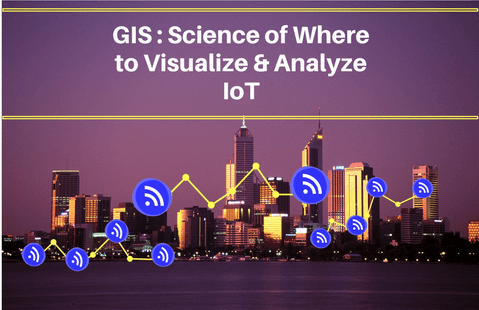
Recently I was fascinated by an infographic outlining facts and statistics about Internet of Things or IoT. It was projected IoT connections will grow to 50 billion by 2020, from about 28 billion connected devices currently. While I am not a subject matter expert in IoT, I am particularly interested to see how GIS fits into the larger scheme of IoT.
According to Gartner, IoT is the network of physical objects that contain embedded technology to communicate and interact with their internal states or the external environment. A search on Wikipedia defines IoT as the inter-networking of physical devices, vehicles (also referred to as “connected devices” and “smart devices”), buildings, and other items—embedded with electronics, software, sensors, actuators, and network connectivity that enable these objects to collect and exchange data. IoT is fueled by consumerization of IT user behavior, pervasiveness of smart devices, fast/reliable internet connectivity and advancement in computing power.
In layman term, IoT is referring to a system of smart devices that are connected and communicated with each other in internet. By and large, this real time or almost real time information exchange between/among devices, (combine with proper human and artificial intelligence) shall help promote better decision making and process optimization from individual to national security level.
Gartner also identified top 10 technologies that will enable organizations to unlock the full potential of IoT in 2017 & 2018. Among the IoT technologies that will have a very broad impact on organizations business strategy is IoT Analytics – an IoT business models that will exploit large, converged information collected by integrated “things” or “sensors” and empower users with more understanding (i.e. to understand customer footfall shopping behavior) and better decision making (i.e. to choose the best route for service delivery).
This reminds me of a favorite quote from Richard Saul Wurman, Founder of TED – “understanding precedes action”. With so many proliferation of “things”, it is no doubt crucial for us to be able to track all these assets, collate and analyze their information feeds, understand them before taking meaningful actions to take advantage of this convergence of IoT. This is where I reckon GIS as “Science of Where” will fits in the larger scheme of IoT.
GIS or Geographical Information System allows us to capture, analyze and present our data spatially in a map. GIS allows us to make better decision by applying geography, which in essence is science of where. GIS enables us to organize our information geographically, provide insights through powerful spatial analytics, and visualize these information dynamically on our smart devices.
Modern enterprise GIS is equipped with robust data integration capability and powerful geospatial analytic that allow users to collect, use, analyze, share information products anywhere, anytime on any devices. In my opinion, GIS will enhance IoT beyond capability as “system of record” for just data storage and management into a “system of insight” and “system of engagement”. GIS will complement IoT to create a system of systems or in IoT context – system of things by allowing users to:-
- Track and visualize location of their IoT assets
- Understand relationship between different “things”
- Visualize and understand the trends/patterns among IoT assets
- Pinpoint location where and when something happened
- Isolate noises and reveal relevant information for better decision making
GIS will empower users of IoT to discover, use, make, share geo-information products on any devices, anywhere and anytime. Hence I am convinced GIS fits well in the overall fabric of IoT. GIS can and will complement IoT with its powerful visualization and analytic which in turn will help to address information anxiety among IoT users.
“Information anxiety is the black hole between data and knowledge, between what we understand and what we think we should understand, and it happens when information doesn’t tell us what we want or need to know.” – Richard Saul Wurman, TED Founder
